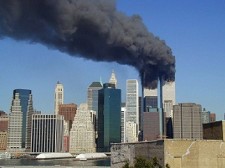2002 FIN – World Trade Center Collapse Not Result of Bolt Failure, Despite Reports
October 29, 2002 FIN – Media reports that an upcoming Massachusetts Institute of Technology study blames the collapse of the World Trade Center on bolts in the floor trusses appear to be erroneous.
The New York Post and Associated Press reported that the unpublished 150-page study, conducted by engineers at MIT, faults the use of “single-bolt connections in the framework” of the towers as contributing to the structures’ demise.
The Post quoted MIT professor Eduardo Kausel, one of the study’s authors, as declaring “the single-bolt support of the floor trusses was the towers’ ‘Achilles’ heel.’”
Those reports appear to be false. MIT said the reports were “in error,” and Kausel told FIN the articles were a “gross oversimplification” of the facts. The trusses were attached to the exterior columns with a twin-bolt system supported by a gusset plate and multiple welds, not a single-bolt connection as reported.
Kausel: Bolts not faulty
Kausel said that the intense heat from the fires made some of the steel trusses sag in the middle, eventually causing the truss bolts to shear. But he stressed that the erection bolts – 5/8” diameter ASTM A325 – were not faulty.
“Those bolts were never intended to bear that load.”
Industrial Fastener Institute managing director Rob Harris agreed, telling FIN the issue “is a question of construction design, not nut or bolt strength selected.”
Kausel said the MIT study was completed last spring but has been delayed by copyright legalities with the publisher. And he emphasized that the study’s focus was much broader than the fasteners used to construct the buildings.
“It was not about the bolts.”
The Post reported the MIT study had concluded the WTC’s design may have contributed to its destruction. Kausel debunked that conclusion. In a statement released by MIT on Sept. 24, 2001, Kausel, a professor of civil engineering, credited the Twin Towers’ designers for the “remarkably long period of time” the towers remained standing. “This extraordinary capability allowed many lives to be saved,” he stated.
Sharp: Design not to blame for collapse
David Sharp of TurnaSure LLC, who is working with the Commerce Department’s National Institute of Standards & Technology, echoed Kausel’s conclusion.
“It is safe to say that the average ‘traditional building’ would have collapsed immediately upon the impact of these aircraft,” Sharp told FIN.
NIST is currently conducting a $16 million, 2-year investigation into the structural failure and progressive collapse of the Twin Towers and other structures at the WTC. The floor-truss connections to the perimeter columns is one of many issues NIST is studying. Other aspects include analysis of building and fire codes, structural performance, and active fire protection systems.
Sharp led a team of volunteer structural engineers who salvaged pieces of steel from the rubble for further study. As of Oct. 8, the last of the salvaged steel was shipped to NIST labs in Gaithersburg, MD, for forensic analysis.
One of the facts the salvaged steel revealed was that the floor truss panels were connected to the perimeter columns by two erection bolts, Sharp stated.
Sharp said the ongoing NIST research promises to be the most comprehensive WTC study to date, and “may point towards opportunities for refinement of ASTM or other worldwide structural bolt specifications.” ©2002/2015 Fastener Industry News.
For information on permission to reuse or reprint this article please e-mail: FIN@GlobalFastenerNews.com©2002 FastenerNews.com




There are no comments at the moment, do you want to add one?
Write a comment